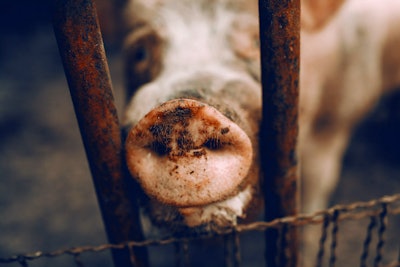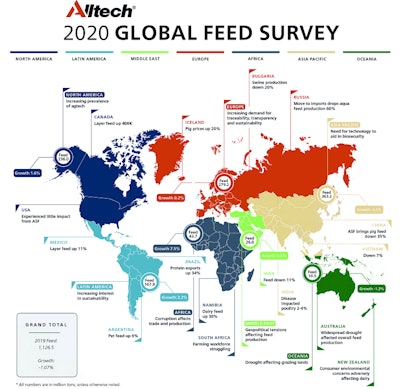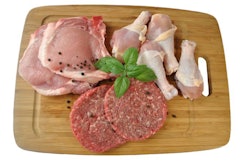
A look at animal feed production trends in China and Southeast Asia
Despite significant losses from African swine fever (ASF), the Asia-Pacific region had a strong showing in the ninth annual Alltech Global Feed Survey, with China, India and Japan ranking among the top 10 feed-producing countries.
Historically, the survey has shown China to be the global leader in feed production; however, this year, with a decrease of 20 million metric tons and a reassessed calculation of the United States’ feed production, China dropped to second place in global feed production.
Overall, the feed industry in the Asia-Pacific region has been greatly impacted by ASF, with major declines in swine population and feed production.
Impacts of disease on the feed industry
Despite its historical year-on-year growth, China’s total feed production fell below expectations for the year and is expected to decline by 11% compared to 2018. This can be primarily attributed to ASF, which struck China most severely, with a 35% reduction in swine feed production reflecting the even steeper herd losses.
According to the Ministry of Agriculture and Rural Affairs of the People’s Republic of China, in the first half of 2019, as the output of pig feed decreased, so did concentrate and premix supplementation. Meanwhile, feed production for poultry picked up its pace by 13%, presumably capitalizing on the protein opportunity created by China’s pork losses.
Although Taiwan has maintained consistent growth due to its domestic consumption of pork, the government has faced pressure to begin importing pork from the U.S. for greater security in the event of an ASF outbreak. While the majority of pork products consumed in Taiwan are domestically produced, a recent export approval for Taiwanese pork could help to maintain internal production numbers.
Vietnam’s feed industry numbers have been dramatically impacted by ASF. At the beginning of Q4 2019, estimates indicated a reduction of around 40–50% of the country’s swine herd population. As with many Asian countries affected by ASF, there have been increases in poultry production — approximately 11% in Thailand and 15% in Vietnam — to compensate for the reduced protein supply. The swine losses are all the more devastating for Vietnam, which was just rebounding from a 20% swine inventory loss in 2017 as a result of China imposing a trade ban on pork meat exported from the country.
Japan is still free of ASF but has experienced classical swine fever (CSF), and swine feed production there has decreased by 1%. The CSF epidemic has led to the culling of approximately 152,000 pigs by the end of September 2019, around 1.7% of the total pigs in Japan.
Malaysia and Indonesia are primarily Muslim countries, so ASF has not impacted those markets, but avian flu has impacted chicken production there, with approximately 10% of feed wasted.
In India, viral diseases in poultry impacted 5% of industry growth, and in the aquaculture industry, Enterocytozoon hepatopenaei (EHP) has severely affected shrimp farming.
 Alltech’s annual Global Feed Survey is derived from feedback from 30,000 feed mills in 140 countries. (Courtesy Alltech)
Alltech’s annual Global Feed Survey is derived from feedback from 30,000 feed mills in 140 countries. (Courtesy Alltech)Consumer trends affecting the feed industry
China’s middle class is growing rapidly. It is estimated that, by 2025, there will be more than 900 million people in China’s middle class. This rising middle class lives a fast-paced life and is looking for quick take-home meals or on-the-go fast food. However, younger generations will not sacrifice safety and they simultaneously demand higher-quality and healthy food, adding to the expectations that food production companies and agricultural producers must meet.
In India, the non-vegetarian population is growing in urban areas. Consumers are focused on quality milk. They are also concerned about the overuse of antibiotics, particularly as growth promoters for the increased production of chicken and milk.
The Philippines’ economy is growing slowly, and its emerging middle class is consuming more red meat, fruits and vegetables. Those who fall into the upper middle class are more conscious about what they eat. Trends in keto and plant-based diets, meal delivery services and healthier food choices are on the rise as consumers become more conscious of what they eat and are willing to spend more for healthier options.
Environmental and sustainability efforts
Environmental sustainability initiatives, which are mainly driven by the government of China, are impacting livestock production. As a result of ASF, the Chinese government has also issued a series of policies to support the Chinese pig industry. The Ministry of Agriculture and Rural Affairs of the People’s Republic of China published a three-year action plan designed to accelerate recovery and further develop pig production. This includes not only disease prevention and control but also financial support, fiscal subsidy, a policy on land use, waste processing and slaughter layout.
Meanwhile, in Japan, the government is deliberating introducing a “green tax” on animal producers, and some of the leading integrators are starting to consider energy recycling/reduction to decrease their farms’ environmental impact. However, consumers are not showing signs that they are ready to pay more in support of these efforts.
In Vietnam, the government is looking to reduce antibiotics as growth promoters, while in Singapore, more feed producers are using organic minerals, as that country’s government is focused on the heavy metal issue in fertilizer. India is making an effort to increase environmental sustainability through manure production plants, decreasing the use of pesticides, increasing the use of organic fertilizers and practicing waste management.
About the 2020 Alltech Global Feed Survey
The annual Alltech Global Feed Survey is an assessment based on Alltech’s work with nearly 30,000 feed mills, as well as industry and government entities from more than 140 countries. The survey’s findings represent the most robust and comprehensive analysis of the feed industry available. To explore the survey data in an interactive map, visit Alltechfeedsurvey.com.


















